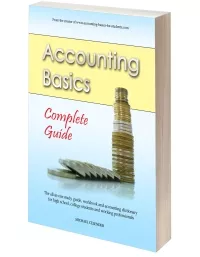Accounting Equation:
Liability Examples
Previous lesson: Owners Equity Example
Next lesson: Asset Purchase Example
In this lesson we're going to go over some liability examples for our sample business, George's Catering. We'll first see how the accounting equation is affected when we enter into a liability, and then we'll see what happens when we pay this off.
Be sure to check your understanding of this lesson by taking the quiz in the Test Yourself! section further below. And right at the bottom of the page, you can find more questions on the topic submitted by fellow students.
Liability Example #1: Taking Out a Loan
In our first lesson George deposited $15,000 of his personal funds into the business. The accounting equation for George's Catering therefore stands at $15,000 assets and $15,000 owner's equity.
b) George realizes that he needs more money to create a really high-quality catering business. Yet he does not have any more personal funds available to invest in the business. He decides to take a loan from the bank to the value of $5,000.
This easiest part of working out what the impact is on the accounting equation is first looking at cash. As you can see, $5,000 more cash is available for the business. Since cash is an asset, this means that our assets are increasing.
The second part is looking at the source of this cash. In this case, the cash was obtained through a loan, which is a liability.
Are liabilities increasing or decreasing? Answer is that they're increasing - George's Catering has more debt now - they had $0 liabilities previously, but now they owe $5,000.
In our previous example the assets were funded by the owner, so assets and owners equity changed, with liabilities amounting to zero. This time the assets and liabilities changed, but not the equity.
The liability means that external parties (the bank) now have a $5,000 claim to the total assets of the business.
The owner’s stake in the assets of the business is unaffected - still $15,000. The owner now really owns only 75% of the assets ($15,000 / $20,000).
Want to see the journal entry for this transaction?
Liability Example #2: Repaying the Loan
This second liability example is taken from a later section of my basic accounting book after a few other transactions already took place. At this stage, George's Catering consisted of:
- $30,800 assets ($12,000 baking equipment and $18,800 bank),
- $25,800 owner's equity and
- $5,000 liabilities (the bank loan).
k) George sees that he has quite a bit of spare cash, and so decides to pay back most of the loan from the bank. He writes out a check for $4,000. What happens to our equation?
This second example is the exact opposite of the first one: instead of receiving money from the bank, we're paying them back.
Again the easiest part of this transaction is the cash component. A loan repayment of $4,000 is made. This means that our cash or bank decreases.
Since cash or bank is an asset, our assets decrease by $4,000.
The second part is looking at what this payment is for. The payment is for the loan, a liability. Since we're paying it off, does this mean our loan is going to increase, decrease or stay the same? The answer is that the loan is going to decrease. This means that liabilities decrease by $4,000.
So both our bank (assets) as well as the loan (liabilities) are going to decrease:
George’s Catering now consists of assets of $26,800, made up of baking equipment to the value of $12,000, and $14,800 bank ($18,800 - $4,000).
The liability to the bank has decreased from $5,000 to $1,000.
Test Yourself!
Before you start, I would recommend to time yourself to make sure that you not only get the questions right but are completing them at the right speed.
Difficulty Rating:
Beginner
Quiz length:
2 questions
Time limit:
4 minutes
Important: The solution sheet on the following page only shows the solutions and not whether you got each of the questions right or wrong. So before you start, get yourself a piece of paper and a pen to write down your answers. Once you're done with the quiz and writing down your answers, click the Check Your Answers button at the bottom and you'll be taken to our page of solutions.
Good luck!
Okay, so that's it for our accounting equation liability examples. I hope that all makes sense!
If you're having any difficulty with understanding the examples above, it would probably be a very good idea to check out our earlier lesson on the Basic Accounting Equation.
Otherwise, feel free to move forward to our next lesson, where you'll see what the effect is on the accounting equation of purchasing assets.
Return from Accounting Equation: Liability Examples to Basic Accounting Transactions
Return from Accounting Equation: Liability Examples to the Home Page
*Greatful thanks to Svilen Mushkatov for permission to use his "Bank Building" image above.
Stay up to date with ABfS!
Follow us on Facebook:
Previous lesson: Owners Equity Example
Next lesson: Asset Purchase Example
Questions Relating to This Lesson
Click below to see questions and exercises on this same topic from other visitors to this page... (if there is no published solution to the question/exercise, then try and solve it yourself)
Accounting Equation Liability Example: Capital vs Interest
Q: In the liabilities example, when George pays the bank part of his loan for $4000, the amount is deducted from the bank account. Why is it not deducted …
© Copyright 2009-2023 Michael Celender. All Rights Reserved.
Click here for Privacy Policy.










Comments
Have your say about what you just read! Leave me a comment in the box below.